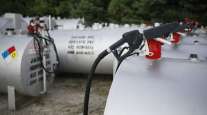Diesel Average Rises Above $4; Price Is Highest Since Mid-May
This story appears in the March 5 print edition of Transport Topics.
U.S. diesel prices surged last week, crossing the important psychological $4-a-gallon threshold and reaching their highest level since May 16, according to the Department of Energy.
The national average retail price added 9.1 cents last week, the largest one-week gain in more than three months, to reach $4.051 per gallon, DOE’s weekly survey of filling stations showed on Feb. 27.
Editor’s note: Diesel rose 4.3¢ to $4.094/gal., DOE reported March 5.
The average price of trucking’s main fuel has now risen 26 cents over the past six weeks, leaving it 33.5 cents higher than a year earlier.
This is the first time the diesel average has exceeded $4 a gallon since Nov. 21. The increase of 9.1 cents was the highest since a 10-cent spike on Nov. 14.
The agency also said retail gasoline increased 13 cents to $3.721 per gallon. Since Dec. 5, gasoline has risen 43.1 cents and is 33.8 cents above year-ago levels.
It is also the highest level ever for gas during February, and is just over 2 cents from last year’s high, set on May 9, according to DOE data.
An analyst said a severe cold snap in Europe, strong diesel exports out of the United States and continued tensions in the Middle East were all reasons why crude oil — as well as petroleum prices — has been rising.
“You’re seeing a war premium being built into the cost of crude and that’s the main factor in the cost of diesel,” said Phil Flynn, senior market analyst at PFG Best. He added that diesel exports are strong as global demand for diesel remains high. “You put all of this stuff together and that’s what driving these (high) prices.”
Crude oil on the New York Mercantile Exchange was trading at about $105 a barrel late last week. Though that was several dollars below where it started the week, it was about $10 higher than a year ago.
With prices rising so fast, one trucking executive said fuel surcharges cannot recoup all the money being shelled out by fleets for fuel.
“We just don’t make it all back,” said Bob Holman, president of refrigerated hauler Holman Transportation Services Inc., Caldwell, Idaho. “We may make 80% of increases back, but that’s only on the best of the surcharges.”
He added: “Our revenue goes up because of fuel surcharges, but all we’re doing is paying for fuel. We need to recoup the millions in investment we’re making.”
In a Feb. 24 television interview with PBS, Bob Costello, chief economist of American Trucking Associations, said that $4 a gallon is “typically the threshold where fuel becomes your highest cost. It surpasses labor at $4. So that really puts a lot of pressure on all carriers, but small carriers in particular.”
He said while more carriers have fuel surcharges in place than during previous price spikes, “I have every reason to believe that there could more (trucking) failures coming.”
ATA Chairman Dan England, who is also chairman of C.R. England Inc., described his company’s efforts on fuel management at the recent Technology & Maintenance Council annual meeting.
He said the Salt Lake City refrigerated carrier operates more than 4,300 highway tractors and runs sophisticated SAE Type IV fuel-mileage tests to evaluate efficiency claims. England managers have analyzed super-single or wide-based tires, trailer skirts and fairings, automated transmissions and tractor designs.
As a result, England said, the company’s average fuel economy rose to 6.8 miles per gallon last year, from 6 mpg in 2008. The wide-based tires and fairings already have a positive return-on-investment, he said, adding that the automated transmissions are not yet an obvious buy for the company.
“AMTs are better on mileage, but the extra cost doesn’t justify them yet — but that will change,” he said, referring to the probability of fuel costs rising further.
Similarly, Holman Transportation has tried a variety of fuel cost-cutting ideas for its 110-truck fleet, including side skirts.
“The side skirts work, there’s no doubt about that. And they definitely pay for themselves,” Holman said.
The company also employs alternative power units, but they require a lot of maintenance, Holman said.
Holman also said one weapon he employs against higher fuel costs is common sense.
“When fuel goes up, it costs us more money to keep the freight cold. If I can’t get the price up, then I walk away from the freight,” he said. “We have to make a pro-fit, too.”
Associate News Editor Jonathan S. Reiskin contributed to this report from Tampa, Fla.




